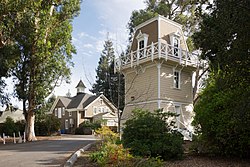Holbrook-Palmer Estate
Holbrook-Palmer Estate | |
 The historic Carriage House and Water Tower in Holbrook-Palmer Park, Atherton, California | |
 Holbrook–Palmer Estate | |
| Location | 150 Watkins Avenue, Atherton, California |
|---|---|
| Coordinates | 37°27′52″N 122°11′29.3″W / 37.46444°N 122.191472°WCoordinates: 37°27′52″N 122°11′29.3″W / 37.46444°N 122.191472°W |
| Area | 22-acres |
| Architect | Henry C. Macy |
| Architectural style | Second Empire style, Colonial Revival-style |
| NRHP reference No. | 16000663 |
| Added to NRHP | 2016 |
Holbrook-Palmer Estate, also known as Elmwood is a historic estate and public park located at 150 Watkins Avenue in Atherton, California (the town was previously named Fair Oaks).[1] The water tower (c.1883) and the carriage house (c.1897) were listed on the National Register of Historic Places on September 26, 2016.[2][3]
History[]
Charles C. Holbrook (1830–1926) was a successful wholesale hardware and mining supply store owner in San Francisco, he created the grand rural estate of Elmwood in the late 19th century.[2] Beginning in 1883, the Holbrook family would summer in the house together and occasionally visit on the weekends during the slower seasons.[4]
In 1926, Olive Holbrook Palmer (1878–1958) inherited the estate which was then named "Elmwood" which she used as her summer home with her spouse Silas H. Palmer (1874–1963).[5] Their main house was in San Francisco, the 22-room Holbrook mansion located at the corner of Van Ness Street and Washington Street.[4] Up until the mid-1950s, the estate was still operating as a farm and did not seem to have any major architectural or landscape changes.[4] When Olive died in March of 1958, the couple did not have an heirs and she willed the estate to the city of Atherton for recreational purposes.[4]
Architecture[]
The Elmwood water tower was built in c.1883, designed by San Francisco architect Henry C. Macy in a Second Empire style and is a rare example of a nineteenth-century tank house that was made in a less utilitarian style (in order to match the main house).[2] The water tower is three stories tall and is built with lumber, featuring an ornamental balcony and a French mansard roof.[4]
The main house was built c.1875 in the same Second Empire style, but was replaced in 1959.[2][4]
The carriage house (also known as the Gen Merrill Carriage House) was built in c.1897 in a Colonial Revival style.[2][4] The carriage house is two stories tall with the first floor featuring stables, a tack room and carriage storage, and a hay loft and bunkhouse in the second story.[4] The carriage house features a hip and gable roof with asphalt shingles and redwood siding.[4]
See also[]
References[]
- ^ Starr, Walter A. (1958-06-01). "Olive Holbrook Palmer". California Historical Society Quarterly. 37 (2): 181–181. doi:10.2307/25155182. ISSN 0008-1175.
- ^ a b c d e "Holbrook--Palmer Estate, "Elmwood""". National Register of Historic Places, National Park Service. Retrieved 2020-10-01.
- ^ Wood, Barbara. "Holbrook-Palmer Park buildings could get national historic status". The Almanac News. Retrieved 2020-10-01.
{{cite web}}: CS1 maint: url-status (link) - ^ a b c d e f g h i "National Register of Historic Places Registration Form" (PDF). National Park Service, United States Department of the Interior. 2016-09-26.
{{cite web}}: CS1 maint: url-status (link) - ^ "Bellows from Holbrook-Palmer Estate, c. 1926-1958". The San Mateo County Historical Association Online Collections Database.
{{cite web}}: CS1 maint: url-status (link)
- Houses in San Mateo County, California
- Second Empire architecture in California
- National Register of Historic Places in San Mateo County, California


